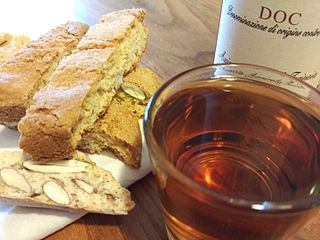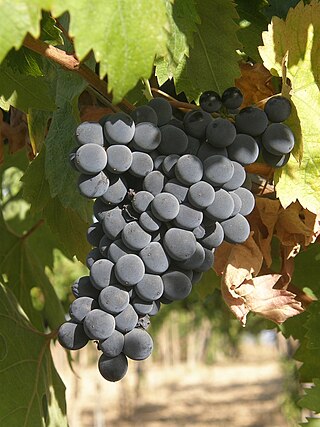
Chianti is an Italian red wine produced in the Chianti region of central Tuscany, principally from the Sangiovese grape. It was historically associated with a squat bottle enclosed in a straw basket, called a fiasco. However, the fiasco is now only used by a few makers of the wine; most Chianti is bottled in more standard-shaped wine bottles. In the latter nineteenth century, Baron Bettino Ricasoli helped establish Sangiovese as the blend's dominant grape variety, creating the blueprint for today's Chianti wines.

Verdicchio is a white Italian wine grape variety grown primarily in the Marche region of central Italy. The name Verdicchio derives from verde and refers to the slight green/yellow hue that wines made from the grape can have.

Vernaccia is a white wine grape that is found in many Italian wines but is most commonly associated the Tuscan wine Vernaccia di San Gimignano. Ampelographers have determined that the Vernaccia vine has many clonal varieties but is unrelated to some Italian vines known as "Vernaccia" such as the Sardinian varieties used in the Sherry-like wine Vernaccia di Oristano, the Trentino-Alto Adige/Südtirol red wine grape known as Vernatsch or the black grape used in the red sparkling wine of the Marche Vernaccia di Serrapetrona. A possible reason for this is that the root of the name Vernaccia translates to different Italian vernaculars and other languages and can apply to any local grape.

Vin Santo is a style of Italian dessert wine. Traditional in Tuscany, these wines are often made from white grape varieties such as Trebbiano and Malvasia, though Sangiovese may be used to produce a rosé style known as "Occhio di Pernice" or eye of the partridge. The wines may also be described as straw wines since they are often produced by drying the freshly harvested grapes on straw mats in a warm and well ventilated area of the house. Though technically a dessert wine, a Vin Santo can vary in sweetness levels from bone dry to extremely sweet. While the style is believed to have originated in Tuscany, examples of Vin Santo can be found throughout Italy and it is an authorised style of wine for several denominazione di origine controllata (DOCs) and indicazione geografica tipica (IGTs).

Aleatico is a red Italian wine grape variety. It is notable for being the primary grape in the cult wine Aleatico di Portoferraio made in Elba. In Chile is known as Red Moscatel. The grape has also been cultivated at Mudgee in New South Wales and California.

Montepulciano is a red Italian wine grape variety that is most noted for being the primary grape behind the DOCG wines Colline Teramane Montepulciano d'Abruzzo and Offida Rosso; and the DOC wines Montepulciano d'Abruzzo, Rosso Conero, and Rosso Piceno Superiore.
Vernaccia di Oristano is a white Italian wine grape variety grown on the island of Sardinia which makes a wide range of wine styles for the Denominazione di origine controllata (DOC) of Vernaccia di Oristano based in the province of Oristano. This includes both dry and sweet wines as well as fortified "sherry-like" wines aged in a solera. The grape has a long history on the island of Sardinia with Sardinians claiming that consuming ample quantities of wine produced from the grape as being responsible for low instances of malaria on the island.

Tuscan wine is Italian wine from the Tuscany region. Located in central Italy along the Tyrrhenian coast, Tuscany is home to some of the world's most notable wine regions. Chianti, Brunello di Montalcino and Vino Nobile di Montepulciano are primarily made with Sangiovese grape whereas the Vernaccia grape is the basis of the white Vernaccia di San Gimignano. Tuscany is also known for the dessert wine Vin Santo, made from a variety of the region's grapes. Tuscany has forty-one Denominazioni di origine controllata (DOC) and eleven Denominazioni di Origine Controllata e Garantita (DOCG). In the 1970s a new class of wines known in the trade as "Super Tuscans" emerged. These wines were made outside DOC/DOCG regulations but were considered of high quality and commanded high prices. Many of these wines became cult wines. In the reformation of the Italian classification system many of the original Super Tuscans now qualify as DOC or DOCG wines but some producers still prefer the declassified rankings or to use the Indicazione Geografica Tipica (IGT) classification of Toscana. Tuscany has six sub-categories of IGT wines today.
Greco is an Italian wine grape that may be of Greek origin. The name relates to both white and black grape varieties. While there is more land area dedicated to Greco nero, the Greco bianco is the grape most commonly referred to by "Greco". In the Campania region it is used to produce the denominazione di origine controllata e garantita (DOCG) wine Greco di Tufo. In Calabria, it is used to make the denominazione di origine controllata (DOC) wine Greco di Bianco. The name "Greco" is sometimes used as a synonym for several varieties of supposed Greek origins-most notably Trebbiano.

Grechetto or Grechetto bianco is a white Italian wine grape variety of Greek origins. The grape is planted throughout central Italy, particularly in the Umbria region where it is used in the Denominazione di origine controllata (DOC) wine Orvieto and Denominazione di origine controllata (DOC) wine Valdichiana Toscana. It is primarily a blending grape, though some varietal wine is also produced. Grechetto is commonly blended with Chardonnay, Malvasia, Trebbiano and Verdello. The grape's thick skin provides good resistance to downy mildew which can attack the grape late in the harvest season. This makes Grechetto a suitable blending grape in the production of Vin Santo.
Drupeggio is a white Italian wine grape variety that is grown in the Central Italy wine regions of Tuscany and Orvieto. The grape is often confused for the white Tuscan variety Vernaccia di San Gimignano, which is also known under the synonym Canaiolo bianco and may be counted as one and the same in field blends.

Carmignano is an Italian wine region located in the Tuscany region and centered on the city of Carmignano, near Prato and about 10 miles northwest of Florence. Noted for the quality of its wines since the Middle Ages, Carmignano was identified by Cosimo III de' Medici, Grand Duke of Tuscany as one of the superior wine producing areas of Tuscany and granted special legal protections in 1716. In the 1800s, the producers of the Carmignano region developed a tradition of blending Sangiovese with Cabernet Sauvignon, long before the practice became popularized by the "Super Tuscan" of the late 20th century. In 1975, the region was awarded Denominazione di origine controllata (DOC) status and subsequently promoted to Denominazione di Origine Controllata e Garantita (DOCG) status in 1990. Today Carmignano has approximately 270 acres (110 ha) planted, producing nearly 71,500 gallons of DOCG designated wine a year.

The history of Chianti dates back to at least the 13th century with the earliest incarnations of Chianti as a white wine. Today this Tuscan wine is one of Italy's most well known and recognizable wines. In the Middle Ages, the villages of Gaiole, Castellina and Radda located near Florence formed as a Lega del Chianti creating an area that would become the spiritual and historical "heart" of the Chianti region and today is located within the Chianti Classico Denominazione di Origine Controllata e Garantita (DOCG). As the wines of Chianti grew in popularity other villages in Tuscany wanted their lands to be called Chianti. The boundaries of the region have seen many expansions and sub-divisions over the centuries. The variable terroir of these different macroclimates contributed to diverging range of quality on the market and by the late 20th century consumer perception of Chianti was often associated with basic mass-market Chianti sold in a squat bottle enclosed in a straw basket, called fiasco.
Biancame is a white Italian wine grape variety that is grown in the Marche and Emilia-Romagna regions of Italy. Here it is an important component in the Denominazione di origine controllata (DOC) wines of Bianchello del Metauro and Colli di Rimini.
Est! Est!! Est!!! di Montefiascone is an Italian wine region centered on the commune of Montefiascone in the province of Viterbo in Lazio. Since 1966, the white Trebbiano and Malvasia bianca-based wines produced within the 1,000 acres (400 ha) of the region can qualify for Denominazione di origine controllata (DOC) designation under Italian wine laws.

Pecorino is a white Italian wine grape variety that grows in the Marche, Abruzzo, Tuscany, Umbria and Lazio regions of Italy. Ampelographers believe that the grape is likely native to Marche, where the soil destined for this cultivation increases every year. This grape variety is used to produce the DOCG wines, like the Offida Pecorino DOCG, and the DOC wines, like the Falerio dei Colli Ascolani, the Colli Maceratesi and the Falerio dei Colli Ascolani.
Colline Lucchesi is a denominazione di origine controllata (DOC) for wine, created in 1968, that is located in northern Tuscany, Italy, and centered near the commune of Lucca.
Rossola nera is a red Italian wine grape variety that has been growing in the Valtellina region of Lombardy since at least the 17th century. In 2004 DNA profiling determined that the grape has a parent-offspring relationship with the Piedmont wine grape Nebbiolo though which variety is the parent and which is the offspring is not yet clear. However, most ampelographers believe that Nebbiolo is likely the parent variety since written records in Piedmont have noted Nebbiolo being grown since at least the 13th century.
Verdello is a white Italian wine grape variety that is grown mostly in the Umbria region of central Italy where it plays a minor role as a blending grape in several Denominazione di Origine Controllata (DOC) wines, including Orvieto. Despite similarities in their names, the Italian Verdello grape has no close genetic relationship with the Portuguese wine grape Verdelho that is grown on the islands of Madeira and Azores. However, like the Portuguese grape, Verdello's name likely comes from the dark green color of its berries before veraison.
Bonamico is a red Italian wine grape variety that is grown in the province of Pisa in Tuscany where the grape has a reputation for producing very high yields. Some ampelographers speculate that the grape may have originated around the town of Palaia with the grape being known under the synonym of Uva di Palaia. While often used as a table grape, Bonamico can be a minor blending component in several Tuscan Denominazione di Origine Controllata (DOC) and Indicazione Geografica Tipica (IGT) wines where it often contributes floral aroma notes and acidity.










